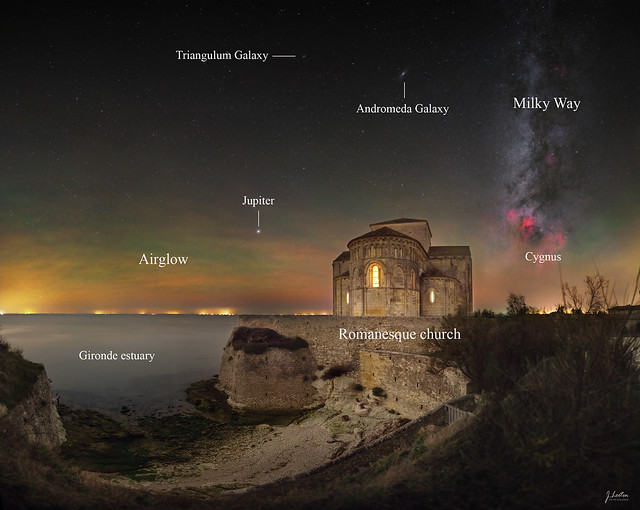by Julien Looten » Sat Dec 30, 2023 1:15 pm
Between Earth, Sky, and Sea
Copyright: Julien Looten
full image :
https://www.flickr.com/photos/julienloo ... en-public/


---
Between Earth, Sky, and Sea.
At the heart of this fusion between Earth, Sky, and Sea, rises majestically the medieval church of Sainte-Radegonde, the keeper of time in Talmont-sur-Gironde, a fortified French village with alleys steeped in history. Perched on the cliffside, overlooking the Gironde estuary, this Romanesque church, akin to a sentinel of the past, was erected in the 12th century by Benedictine monks.
It has inspired numerous authors and writers:
- Pierre-Henri Simon wrote: "At the tip of the rock, wounded but immutable, the winds never cease to strike it; on stormy days, it is enveloped in foam. It truly is the ship anchored on the waves. I know of no more beautiful image (...) of the eternal in the heart of history."
- André Malraux, in front of a poster depicting the fragile church, once declared to visitors: "See these sublime stones, indifferent to the rumors of ages..."
The horizon reveals a sky adorned with multicolored clouds, a rare natural phenomenon called "airglow." This is caused by a chemical reaction in the upper atmosphere, where the sun's rays excite molecules, emitting a very faint light (chemiluminescence) in green and/or orange hues. That evening, it was particularly intense.
To the left of the church, Jupiter emerges as a celestial beacon, its brilliance even reflected in the waters of the estuary.
Above the church, a galactic trio unfolds… First, the Triangle Galaxy and the Andromeda Galaxy. These spirals, composed of billions of stars, are located more than 2 million light-years from Earth. To the right, the Milky Way, our galaxy, our home. The Cygnus constellation gracefully unfolds within it, displaying its red nebulae (North America Nebula, Butterfly Nebula).
Inside the church, a flickering candle gives birth to a warm glow, emanating from the windows.
In this photograph, all elements converge, from the sea caressing the base of the cliff to the steadfast stone of the church, from the starry sky stretching above to the infinite universe.It's a moment frozen in time, where the past, present, and eternity intersect.
---
Panorama of 20 photos, Canon 6d Astrodon - Sigma 28mm F1.4. - 19/12/2022
---
Instagram :
https://www.instagram.com/j.looten/
Facebook :
https://www.facebook.com/Julien.Looten.Photographie/
[size=120][b]Between Earth, Sky, and Sea[/b][/size]
Copyright: Julien Looten
full image : https://www.flickr.com/photos/julienlooten/53430884178/in/datetaken-public/
[url=https://flic.kr/p/2ppvfn1][img]https://live.staticflickr.com/65535/53430884178_3bd13a581b_z.jpg[/img][/url]
[url=https://flic.kr/p/2ppwaos][img]https://live.staticflickr.com/65535/53431062554_fbd48a66c1_z.jpg[/img][/url]
---
Between Earth, Sky, and Sea.
At the heart of this fusion between Earth, Sky, and Sea, rises majestically the medieval church of Sainte-Radegonde, the keeper of time in Talmont-sur-Gironde, a fortified French village with alleys steeped in history. Perched on the cliffside, overlooking the Gironde estuary, this Romanesque church, akin to a sentinel of the past, was erected in the 12th century by Benedictine monks.
It has inspired numerous authors and writers:
- Pierre-Henri Simon wrote: "At the tip of the rock, wounded but immutable, the winds never cease to strike it; on stormy days, it is enveloped in foam. It truly is the ship anchored on the waves. I know of no more beautiful image (...) of the eternal in the heart of history."
- André Malraux, in front of a poster depicting the fragile church, once declared to visitors: "See these sublime stones, indifferent to the rumors of ages..."
The horizon reveals a sky adorned with multicolored clouds, a rare natural phenomenon called "airglow." This is caused by a chemical reaction in the upper atmosphere, where the sun's rays excite molecules, emitting a very faint light (chemiluminescence) in green and/or orange hues. That evening, it was particularly intense.
To the left of the church, Jupiter emerges as a celestial beacon, its brilliance even reflected in the waters of the estuary.
Above the church, a galactic trio unfolds… First, the Triangle Galaxy and the Andromeda Galaxy. These spirals, composed of billions of stars, are located more than 2 million light-years from Earth. To the right, the Milky Way, our galaxy, our home. The Cygnus constellation gracefully unfolds within it, displaying its red nebulae (North America Nebula, Butterfly Nebula).
Inside the church, a flickering candle gives birth to a warm glow, emanating from the windows.
In this photograph, all elements converge, from the sea caressing the base of the cliff to the steadfast stone of the church, from the starry sky stretching above to the infinite universe.It's a moment frozen in time, where the past, present, and eternity intersect.
---
Panorama of 20 photos, Canon 6d Astrodon - Sigma 28mm F1.4. - 19/12/2022
---
Instagram : https://www.instagram.com/j.looten/
Facebook : https://www.facebook.com/Julien.Looten.Photographie/